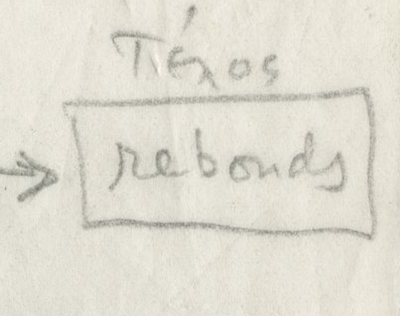Improving the practice and performance of contemporary music
Macro structure
all examples on this page are published with permission of collection Famille Xenakis. DR. and may not be copied unauthorized without permission.
General
Okho’s structure is of the same type of narrative structure as Rebonds A, only the destructive period at the end is much shorter (it consists only of the last bar of the piece, played in unison by all three players) (1). The composition contains, in contrast to Rebonds A, a lot more calculations and mathematical structuring for the different parts. Nevertheless, Xenakis literally copied the last part of Okho (the part that is marked with tempo 70 for an eight note) from the musical text of Rebonds A. In his sketches he states “See Rebonds A” (See also in the chapter above concerning Tempi Alterations in Rebonds A).
The part in the piece that is marked with tempo 66 for an eighth note (measure 80-104) is an indirect quote taken from his piece for 6 percussion and choir, “Idmen” (1985). Xenakis writes in his sketches for Okho “a percussive-rhythmic melody see IDMEN B in the end”. If we consult the score of Idmen B, we see that the complementary rhythm of all players in section PC (the end of Idmen B) of the piece resembles the most to the musical text of this passage in Okho (2).
There are a lot of places in Okho where the three players play in perfect or almost perfect unison. As Barthel states in her thesis on page 275 (3), “Xenakis uses saturated aggregates of sonorities that evolve out of the fusion of different musical lines to strengthen the oppressive characteristics of homo-rhythmic structures” (4). Barthel also states in the chapters before her conclusion that this use of exact unisons was an evolution in the writing of Xenakis in order to “fatten” melodic and rhythmic structures (5).
Mathematical Principles vs. Artistic Liberty
The general structure Xenakis proposes in the sketches differs from the actual result, particularly in the first pages of the sketches, which present a “rough schedule” for the piece. Later on in the sketches, the composer evolves to write increasingly concrete ideas for the piece and starts to elaborate every section in detail. However, some structures we find in the sketches are interjected or omitted later on from the initial structure. The sketches present a general plan for the piece but are frequently altered afterward in function of the music. In the final score we find some examples of measures that seem to be added to the initial calculated parts, and that did not actually appear in the calculations themselves. Xenakis seems to apply a kind of “artistic liberty” to his own applied systems. For example, measures 58-59 and measures 75-80 do not appear in the sketches (6).
Notes
Text written by Tom De Cock © Living Scores 2015
- BARTHEL-CALVET, Anne-Sylvie, Le rythme dans l'oeuvre et la pensée de Iannis Xenakis, thèse de doctorat. Paris, Ecole des Hautes Etudes en Sciences Sociales, 2000, 2 vol., 700 + 482 p.: pp. 578-580
- for reference, see YouTube
- Ibidem p. 275
- Ibidem p. 275: “Les agrégats sonores staurés qui naissent de cette fusion des lignes viennent d’ailleurs renforcer, selon nous, le caractère oppressant des structures homorythmiques”
- Ibidem p. 266: “Le parallélisme des structures mélodiques en assure en effet la fusion sonore en une seule et même entité qui apparait comme un trait mélodique “epaissi”
- BARTHEL-CALVET, Anne-Sylvie, Le rythme dans l'oeuvre et la pensée de Iannis Xenakis, thèse de doctorat. Paris, Ecole des Hautes Etudes en Sciences Sociales, 2000, 2 vol., 700 + 482 p.: pp. 633-634





